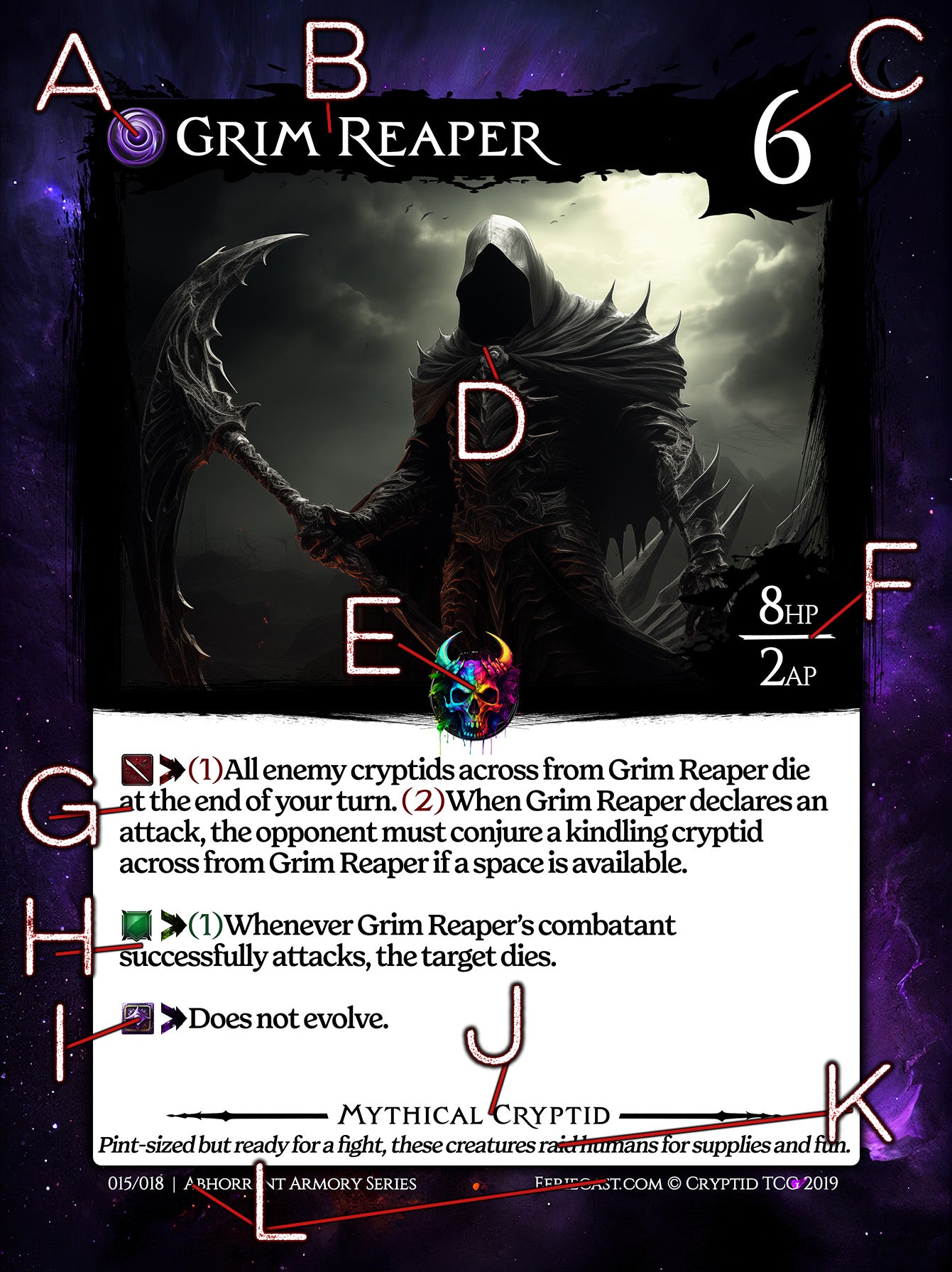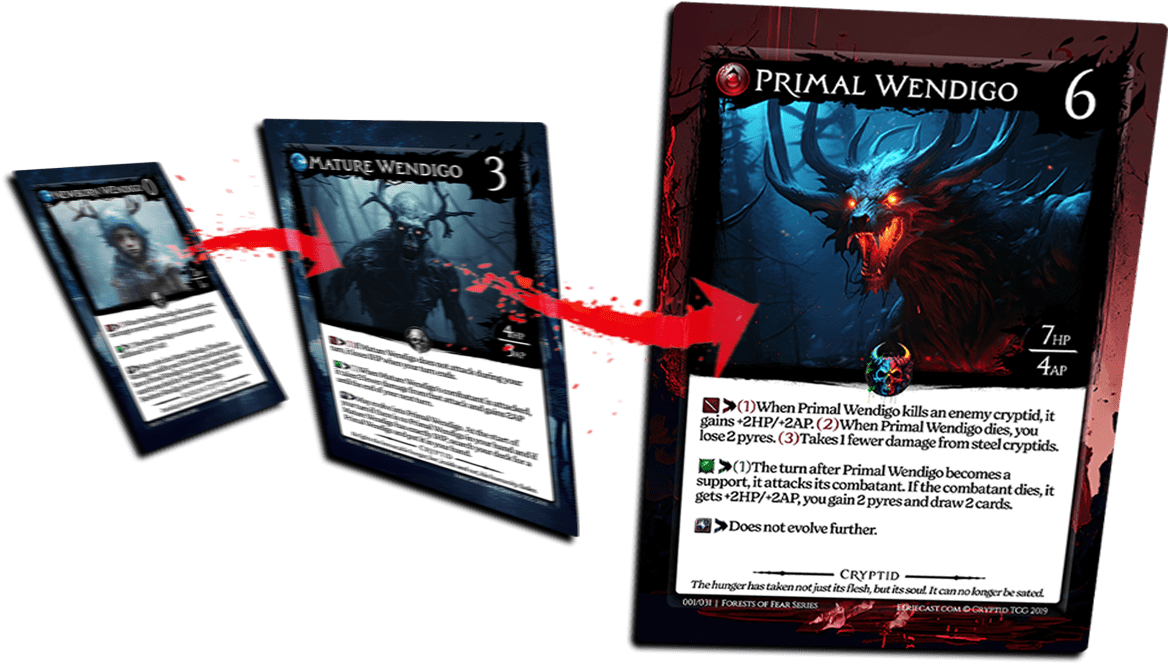CRYPTID: Player's Online Guidebook
Learn to play, discover solutions to confusing scenarios, and understand definitions unique to CRYPTID CCG.
Open a menu and select a page
Table of Contents
Goal and Types of Cards
Parts of a Card
Parts of a Card - Element - Name - Pyre Cost - Artwork - Rarity Skull - HP and AP - Combat Abilities - Support Abilities - Evolution - Card Type - Flavor Text - Metadata
Play Area
How to Play!
Questions and Answers
Parts of a Card
Cryptids and Instances are laid out differently, so let's go over what each one looks like and which aspects you need to be aware of.

Parts of a Cryptid Card
-
A | Element
Each Cryptid has an associated element (sometimes more than one!). Elements are rooted in the nature and folklore of the Cryptid, but they also define its card's strengths and weaknesses. Many cards target certain elements in various ways. For example, when one Cryptid attacks another, it might deal more or less damage depending on which element its target is.
Be aware of this not only when you attack, but also when you place a Cryptid on the field!
The elements are shown below:
- Nature: Cryptids found in forests, jungles and/or grasslands. Nature Cryptids are naturally strong and can often grow stronger on their own, regenerate, or gain Pyres.
- Water: Cryptids found in water, near water, or in snowy ecosystems. Water Cryptids are can be tricky to deal with, often causing effects that slip up players who target them or are targeted by them.
- Steel: Cryptids found near, born from, or prey on civilization. Steel Cryptids are prone to causing afflictions or dealing out "extras" to those afflicted with status ailments.
- Void: Cryptids of unexplained or unnatural origin. Void Cryptids seem to enjoy ambushing victims, scaring them, and treating them with a bout of paralysis (or worse).
- Blood: Cryptids who crave and subsist on violence, terror and blood. Blood Cryptids often bolster themselves upon attacking or killing other Cryptids. When a blood Cryptid is allowed to run rampant, it spells danger for its enemies.

-
B | Name
A Cryptid's name not only identifies it, but also groups it under a category. For example, any card or card ability which targets Vampire Cryptids would work on Cryptids named "Vampire Initiate" and "Elder Vampire".
-
C | Pyre Cost
This is the amount of Pyres required to conjure the card. If the card is an evolution of a Cryptid you have on the field already, and that Cryptid has not evolved this turn, then you can ignore its Pyre Cost and evolve it. Be warned: Evolution saves you Pyres, but you risk losing more Cryptids at once - That is because every previous form of an evolved Cryptid counts as another dead Cryptid when the evolved version dies.
-
D | Artwork
The illustration of the Cryptid - Most of our artwork is AI, unfortunately, but we are going back and commissioning human artwork to replace AI artwork on our cards whenever we can afford to do so.
-
E | Rarity Skull
The rarity of the card. Rare cards are few and far between and are stronger on average. The rarer, the more strength it has, whether that's better abilities or higher stats compared to its Pyre Cost.
The rarity skulls are shown below:
- Common: Basic cards and the most plentiful variety. Their stats and abilities are average.
- Uncommon: Slightly rare cards with decent stats and abilities.
- Rare: Scarce cards with powerful stats and abilities - A single rare card can be a game changer.
- Ultimate: Legendary cards that are extremely limited. However, their stats and abilities are unparalleled. If a player manages to conjure an Ultimate Cryptid, they may have already claimed their victory.

-
F | HP / AP
HP: This acronym stands for "Health Points". It is the amount of damage a Cryptid can take before dying. If, for any reason, a Cryptid's HP becomes equal to or less than 0, it dies. HP of Support Cryptids are granted to its Combatant. HP has no limit as to how high it can go. However, please note that effects referring to "regenerating" HP cannot surpass the combined written and granted HP of the affected card.
AP: This acronym stands for "Attack Points". It is the amount of damage a Cryptid deals when attacking another Cryptid. A Cryptid's AP cannot be permanently reduced to 0 or less by card effects. However, effects that say "until the end of turn" can reduce AP to 0 or lower. AP of Support Cryptids are granted to its Combatant. AP has no limit as to how high it can go.
*Granted Stats: Whenever a Support Cryptid is conjured below a Combatant Cryptid, its HP and AP are given to it for as long as the Support Cryptid is alive. Buffs to HP and AP given to a Support Cryptid are passed through to its Combatant as well. If a Support Cryptid dies, its Combatant loses all granted HP and AP from it. This may cause the Combatant's HP to fall to 0 or less, in which case it dies as well. This is called collapsing.
-
G | Combat Abilities
The red icon next to the text under the artwork of a Cryptid defines its Combat Abilities. These abilities and effects only work whenever the Cryptid is in the combat field. Whenever a Cryptid is in the combat field, it is a Combatant.
-
H | Support Abilities
The green icon next to the text under the artwork of a Cryptid defines its Support Abilities. These abilities and effects only work whenever the Cryptid is in the support field. Whenever a Cryptid is in the support field, it is a Support.
Note: The default position of a Cryptid is the combat field. If a column is empty and you conjure a Cryptid into it, it falls into the combat field. Therefore, a Cryptid can only be in the support field if there is a Combatant already in that column. Whenever a Combatant dies, its Support falls into the combat field immediately after the attack that killed its Combatant, thus making the Support the new Combatant of that column.
-
I | Evolution
Some Cryptids can evolve. If it can, details and conditions of its evolution will be defined next to the purple icon below the Support Abilities of a Cryptid card. Many Cryptids cannot evolve. Some evolutions have specific conditions.
Evolution is free - It does not cost any Pyres unless stated otherwise. Evolutions of the Cryptid you want to evolve must already be in your hand.
For example, if you have an Adolescent Bigfoot on your field already, and you have an Adult Bigfoot in your hand, even if it says it costs 7 Pyres to conjure, you may instead evolve Adolescent Bigfoot into the Adult Bigfoot straight from your hand during your turn without paying the Pyre Cost.
A Cryptid can only be evolved once per turn, even if it has multiple evolutions and they are in your hand. However, you can evolve multiple other Cryptids on your field in a single turn.

-
J | Card Type
Indicates the type of card. There are 3 types of Cryptids (Kindling Cryptid, Cryptid, and Mythical Cryptid) and 5 types of Instances (Trap, Aura, Attack, Burst, and Pyre).
-
K | Flavor Text
Fun, extra info on the card pertaining to folklore.
-
L | Metadata
From left to right, this section lists the number of the card in a series, the name of the series, and the copyright information.

Parts of an Instance Card
-
A | Name
The unique name of the Instance.
-
B | Pyre Cost
How many Pyres you need to Conjure the Instance. Keep in mind, Pyre cards will instead have a "+" sign next to their Pyre cost, indicating it grants you that many Pyres instead of expending them.
-
C | Artwork
The lovely illustration of the Instance.
-
D | Rarity Skull
As with Cryptid cards, Instances vary in rarity, and the rarer an Instance is, the stronger its effects. The rarity levels are the same as listed above in the Cryptid card parts section.
-
E | Instance Effects
This section lists the conditions and effects of an Instance. Pyre cards usually don't have any effects, however there are some special Pyre cards that has detailed effects. Pay attention to their conditions and conjure them at the right time to maximize your advantage.
-
F | Card Type
This indicates the type of card. As with Cryptid cards, there are types of Instances.
- Trap: Traps have orange borders. Their Card Effects usually contain conditions that must be met before they activate. Trap cards must be placed face-down on one of the two trap fields on your field. Because there are only two trap fields, you can only have up to two trap cards out on the field at a time. Whenever a Trap card activates (once its conditions are met), you must turn it face up. If a Trap card's conditions are met, you can choose not to activate it. Traps cannot be conjured during your opponent's turn, however they can be activated during your opponent's turn. Once a Trap has been activated or destroyed, it is placed in the discard pile.
- Aura: Auras are permanent buffs to your Cryptids. When you conjure an Aura card, you must target a Cryptid to "equip" it to. Afterwards, that Cryptid gains the effects listed in the Instance Effects on the card. If an Aura equipped to your Cryptid is destroyed or removed, the effects are removed as well. If this causes a Cryptid's HP to fall to 0 or lower, it dies. If a Cryptid dies and it had Auras or Attacks equipped to it, those cards must be placed in the discard pile.
- Attack: Attack cards are basically new moves for your Cryptids. When you pay the Pyre Cost of an Attack card to conjure it, you must choose a Cryptid to "equip" it to. To activate an Attack card on the equipped Cryptid, you must pay the Pyre Cost shown at the start of the Attack card's Instance Effects (if it has a cost there, that is). Attack cards take the place of a Cryptid's normal attack, and, unless otherwise stated, may only activate during your attack phase like a basic attack. If you use an Attack card's effects, that Cryptid can not basic attack that turn and instead rests (as it would with a basic attack). If a Cryptid dies and it had Auras or Attacks equipped to it, those cards must be placed in the discard pile.
- Burst: Burst cards can be played straight from your hand at any time, even during your opponent's turn. These cards are best played at the correct timing to disrupt your opponent's actions and to protect your field, or to give you a sudden advantage that your opponent was not expecting. Once a Burst card is used, it is placed in the discard pile.
- Pyre: Pyre cards are free to use and grant you the amount of Pyres listed in the usual Pyre Cost space at the top right of the card (indicated by the "+" sign). Most Pyre cards have no Instance Effects, however some special Pyre cards have bonus effects and conditions defined in the Instance Effects space. These effects are in addition to the Pyres gained from the Pyre Cost of the card. For example, if a Pyre card says "+1" at the top right and its Instance Effects say "Gain 1 additional Pyre for each nature Cryptid on your field for up to 3 additional Pyres" when you have 2 nature Cryptids on your field, you would gain 3 total Pyres from the card (2 for the nature Cryptids and 1 for the base Pyre Cost shown at the top right as "+1"). After a Pyre card is used, it must be placed in the discard pile. Be sure to have around 15 or more Pyre cards in your deck to keep your Pyres flowing!
-
G | Flavor Text
Extra, fun information pertaining to the folklore of the Instance.
-
H | Metadata
From left to right, this section details the card number in the series, the title of the series, and the copyright information.
